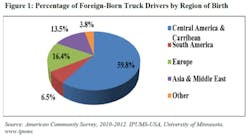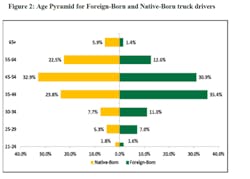When U.S. motor carriers discuss recruiting new drivers they're eager to chat about efforts to reach out to underrepresented groups such as women, minorities and military veterans, but there's one group they're reluctant to discuss for publication: Immigrants.
Schools, organizations and companies that train new drivers also shy away from the subject of immigrant drivers; ditto for some state carrier organizations.
Fleet Owner reached out to eight industry stakeholders with multiple phone calls and email messages to discuss immigrants in the U.S. trucking industry and either received no response or the equivalent of “no comment.”
This reluctance belies the fact that recruitment of immigrant drivers appears to be successful. Currently, of the 1.2 million motor carrier-employed U.S. truck drivers (operating Class 8 trucks) about 224,722 or 18.6% are immigrants, according to U.S. Census data for 2011-2015 as analyzed by Justin Lowry, PhD, a Postdoctoral Researcher at George Mason University's Institute for Immigration Research. Figures for 2010-2012 clocked in at 15.7%, he said.
Although Lowry has looked at other industries, driving jobs (including truckers) stood out as one of the industries that grew in terms of immigrant workers."In general, immigrants in the workforce of the trucking industry are helping to buoy the industry itself because of the lack of workers,” Lowry said. “There's a high demand for truckers and not a whole lot of native-born U.S. who are entering into it. If you look at the age distribution of native U.S. citizens to foreign-born in the trucking industry, you'll note that the U.S.-born tend to be older, because the younger generation of U.S. citizens don't think of trucking as a natural career path."
Where do the immigrant drivers come from? "The top five are Mexico, El Salvador, Cuba, India, and Guatemala," Lowry noted. "Eastern European countries like Poland and Ukraine are next and then it drops off quickly: Dominican Republic, Jamaica, Bosnia, Honduras, Columbia, Russia, and China."
The largest group -- representing 32% of immigrant truck drivers – is from Mexico.
According to the Institute's 2014 report – Who’s Behind the Wheel? Immigrants Filling the Labor Shortage in the U.S. Trucking Industry, authored by Zahra Sohail Khan – the percentage of immigrant drivers is higher than that of the total percentage of immigrants in the U.S., which is estimated at 13%."The proportion of immigrant truck drivers is particularly high in certain states such as California (46.7%), New Jersey (40.4%), Florida (32.2%), and New York (25.7%)," the report noted.
How did U.S.-born truckers react to seeing the report? "After the original release of the truck driving brief, I got some phone calls from truckers who wanted to talk about what was really going on,” Lowry explained. “Some of them were very keyed into workers' rights issues going on in the trucking industry right now where there's an interplay between large corporate trucking companies and the drivers themselves trying to manage the exploitation of low-wage workers."
Several truck drivers Fleet Owner spoke with are concerned that immigrant drivers lower wages for all drivers.
"It's not an uncommon argument for people to make that increasing the size of the workforce drops the wages on the entire workforce," Lowry pointed out. "And I think that it is a difficult argument to contextualize on a larger scale. Even though you may see an initial trend of lower wages for immigrant workers, I don't think that that means that the immigrants are causing the wages to be lower."
He added: "What I can tell you is that there is a demand for new truckers. Now, whether the demand is created by a lack of wages or the demand is created by a lack of interest in the industry, I don't know. I know for a fact that if they would increase wages, they would have higher demand.”
The fundamental fact is when immigrants come into a country they are probably working at the lowest wages, Lowry noted, and that tends to happen across all industries. But as they grow in the field, they tend to bolster it, he stressed.
“If the new immigrant workers are incorporated into the collaborative bargaining groups, then there's a huge power in the communities of immigrants in addition to existing drivers to leverage bargaining power for increased wages or better work conditions," Lowry emphasized.
About the Author

Larry Kahaner
Larry Kahaner is an author, journalist, and former FleetOwner contributor.


